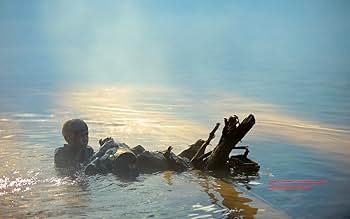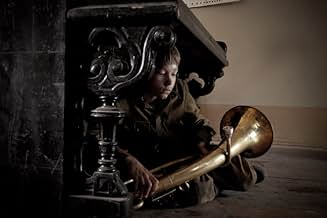AVALIAÇÃO DA IMDb
7,4/10
11 mil
SUA AVALIAÇÃO
Um drama de guerra ambientado durante a invasão nazista da União Soviética em junho de 1941, na qual as tropas soviéticas se mantiveram em um bastião de fronteira por nove dias.Um drama de guerra ambientado durante a invasão nazista da União Soviética em junho de 1941, na qual as tropas soviéticas se mantiveram em um bastião de fronteira por nove dias.Um drama de guerra ambientado durante a invasão nazista da União Soviética em junho de 1941, na qual as tropas soviéticas se mantiveram em um bastião de fronteira por nove dias.
- Prêmios
- 7 vitórias e 14 indicações no total
Aleksey Kopashov
- Sashka Akimov
- (as Alyosha Kopashov)
Anna Tsukanova-Kott
- Sonya
- (as Anna Tsukanova)
Enredo
Você sabia?
- Erros de gravaçãoAround time code 1h20, we see Stukas bombing the fortress. The firsts Stukas pass arrive correctly. The other Stukas have their head down and arrive on the back. Technicians have probably inverted the images.
- ConexõesFeatures Os Rapazes Felizes (1934)
Avaliação em destaque
A convincing and brutal drama about the war's ugly and scary face, which is as much poignant as it is riveting and engrossing from start to finish.
The doomed fortress of the border town of Brest was built a hundred years before the first onset of German deceitful invasion into the Soviet land at early dawn of June 22, 1941. It had been changing hands several times before, notably in 1918 when it was surrendered to the Germans under notorious Brest Peace Treaty. It was released thereafter to the Poles, then liberated by the Red Army, then transferred to Poland again. Under the Polish administration the fortress was first affected by German air raid in 1939 and significantly damaged under the massive onslaught of the German troops.
Before the end of 1939 the city of Brest (and its fortress) was finally incorporated into the Soviet Union. By the commencement of war, the Brest fortress was a home to a number of Soviet military units - infantry battalions, reconnaissance and artillery regiments, miscellaneous attached units and troops, all-in-all up to 8000 servicemen and several hundreds of their families, wives and children were stationed therein.
The film starts unfolding peacefully on the eve of the war - a regular day in the lives of ordinary people in a military compound - orchestra rehearsals, dancing, shopping, kisses, Saturday evening film screening - the late peaceful everyday routine...
Persistent rumors that the Germans were cranking up preparations for a breakthrough on the border were considered as sabotage and eventually suppressed. But anticipation of imminent disaster was intensified by a particularly creepy late night scene of the special vanguard troops disguised in Soviet military uniform disembarking from a train following subdued German language orders.
Heavy artillery fire that all of a sudden pierced silence at the daybreak of June 22 instantly inflicted heavy human and material losses, disrupted communication, cut off power supply and destroyed military munitions. Followed by meticulously coordinated combat assault immediately afterward, it took the inhabitants by surprise and split the garrison into several relatively small and isolated pockets of nevertheless pretty fierce resistance.
Under massive German attacks the city was defeated fairly early, whereas the small number of the besieged Brest fortress survivors with scarce resources, deprived of food, water and medicine, and with narrowing hope for reinforcement or backing from the retreating regular forces, kept on defending the small plot of Soviet land against the invaders for many days.
Though the essence of the story is certainly a portrayal of the valor of Soviet soldiers that lost their lives defending the first citadel and symbol of Russian resistance, the film manages to avoid as much as possible worn-out heroic clichés and propagandistic pathos that were often compulsory elements even in the best examples of Soviet war movies of the past. Yet, unlike many politically engaged modern movies, it resists the temptation to deride the peculiarities of Soviet lifestyle of that time and to speculate on the popular issues of "Stalinist regime's atrocities".
Instead, the film focuses on accurate capturing of a full range of authentic human emotions from joy, love and devotion at the early beginning of the film through angst, fear and pain as it progresses to hopelessness and despair. It tells the frightening story of regular people, which lives were turned upside down overnight when they end up face to face with unstoppable deadly force menacing their families, their loved ones, their own lives and their country.
It pulls no punches when it comes to depiction of enormous destructions and horrors of war with first rate set designs and visually arresting special effects, but the main asset of the film is, of course, excellent nuanced performances from the entire cast especially the leads - Korshunov, Merzlikin and Derevyanko.
The story is told as if from the perspective of a teenage boy witnessing the outbreak of war and providing narration already as a war veteran that has survived the worst war in modern history. It may be emotionally draining cinematic experience for many viewers, but I believe it could be especially conducive for the younger generation to acquire better understanding of the actual tremendous price the nation has paid for the great Victory.
The doomed fortress of the border town of Brest was built a hundred years before the first onset of German deceitful invasion into the Soviet land at early dawn of June 22, 1941. It had been changing hands several times before, notably in 1918 when it was surrendered to the Germans under notorious Brest Peace Treaty. It was released thereafter to the Poles, then liberated by the Red Army, then transferred to Poland again. Under the Polish administration the fortress was first affected by German air raid in 1939 and significantly damaged under the massive onslaught of the German troops.
Before the end of 1939 the city of Brest (and its fortress) was finally incorporated into the Soviet Union. By the commencement of war, the Brest fortress was a home to a number of Soviet military units - infantry battalions, reconnaissance and artillery regiments, miscellaneous attached units and troops, all-in-all up to 8000 servicemen and several hundreds of their families, wives and children were stationed therein.
The film starts unfolding peacefully on the eve of the war - a regular day in the lives of ordinary people in a military compound - orchestra rehearsals, dancing, shopping, kisses, Saturday evening film screening - the late peaceful everyday routine...
Persistent rumors that the Germans were cranking up preparations for a breakthrough on the border were considered as sabotage and eventually suppressed. But anticipation of imminent disaster was intensified by a particularly creepy late night scene of the special vanguard troops disguised in Soviet military uniform disembarking from a train following subdued German language orders.
Heavy artillery fire that all of a sudden pierced silence at the daybreak of June 22 instantly inflicted heavy human and material losses, disrupted communication, cut off power supply and destroyed military munitions. Followed by meticulously coordinated combat assault immediately afterward, it took the inhabitants by surprise and split the garrison into several relatively small and isolated pockets of nevertheless pretty fierce resistance.
Under massive German attacks the city was defeated fairly early, whereas the small number of the besieged Brest fortress survivors with scarce resources, deprived of food, water and medicine, and with narrowing hope for reinforcement or backing from the retreating regular forces, kept on defending the small plot of Soviet land against the invaders for many days.
Though the essence of the story is certainly a portrayal of the valor of Soviet soldiers that lost their lives defending the first citadel and symbol of Russian resistance, the film manages to avoid as much as possible worn-out heroic clichés and propagandistic pathos that were often compulsory elements even in the best examples of Soviet war movies of the past. Yet, unlike many politically engaged modern movies, it resists the temptation to deride the peculiarities of Soviet lifestyle of that time and to speculate on the popular issues of "Stalinist regime's atrocities".
Instead, the film focuses on accurate capturing of a full range of authentic human emotions from joy, love and devotion at the early beginning of the film through angst, fear and pain as it progresses to hopelessness and despair. It tells the frightening story of regular people, which lives were turned upside down overnight when they end up face to face with unstoppable deadly force menacing their families, their loved ones, their own lives and their country.
It pulls no punches when it comes to depiction of enormous destructions and horrors of war with first rate set designs and visually arresting special effects, but the main asset of the film is, of course, excellent nuanced performances from the entire cast especially the leads - Korshunov, Merzlikin and Derevyanko.
The story is told as if from the perspective of a teenage boy witnessing the outbreak of war and providing narration already as a war veteran that has survived the worst war in modern history. It may be emotionally draining cinematic experience for many viewers, but I believe it could be especially conducive for the younger generation to acquire better understanding of the actual tremendous price the nation has paid for the great Victory.
- Abominog
- 1 de dez. de 2010
- Link permanente
Principais escolhas
Faça login para avaliar e ver a lista de recomendações personalizadas
- How long is Fortress of War?Fornecido pela Alexa
Detalhes
- Data de lançamento
- Países de origem
- Central de atendimento oficial
- Idiomas
- Também conhecido como
- Fortress of War
- Locações de filme
- Empresas de produção
- Consulte mais créditos da empresa na IMDbPro
Bilheteria
- Faturamento bruto mundial
- US$ 4.569.604
- Tempo de duração2 horas 18 minutos
- Cor
- Mixagem de som
- Proporção
- 2.35 : 1
Contribua para esta página
Sugerir uma alteração ou adicionar conteúdo ausente































